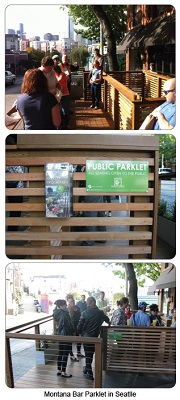They paved paradise and put up a parking lot. The trend of diminishing green space is pretty well summarized in the song “Big Yellow Taxi,” by Joni Mitchell and later the Counting Crows. Luckily for us though, there is a newer trend of taking back some of those parking spaces and converting them into open space and parks—parklets.
The term parklet was coined in San Francisco in 2005 by ReBar, an art studio, when they created the first two hour parklet. Since then, parklets have been one of the ways cities are increasing public open space—either temporarily or more long term. To create a parklet, cities convert on-street parking spots into public spaces for people to read, eat lunch or socialize. Some even include items like exercise balls and swings for people to enjoy a little bit of physical activity. They are often privately designed and funded by local businesses, but use public spaces to operate.
At the NLC Conference last month, we met with Seattle’s Department of Transportation who launched a pilot parklet program in August of 2013 that aims to create new public spaces while ensuring the flow of traffic and parking are maintained. The first installation, Montana Bar parklet, was privately funded by Montana Bar and is open for use by customers of the bar and the public in general. Seattle has more parklets in the works and will evaluate the success of the program to determine whether or not to launch a permanent program. Seattle takes much of its inspiration from San Francisco which launched their parklet program in 2009 and now has nearly 40 public parklets.

Parklets are starting to spread across the U.S. and even around the world. Huntsville, Alabama brought “unexpected fun” to the city when it launched a temporary, three day parklet program and Raleigh, North Carolina is vying for a few of their own to help boost downtown businesses. While not all cities have received the ROI they expected from the parklets, they are still interested in reevaluating and trying again.
Park and recreation agencies interested in starting a parklet program should look to partner with their department of transportation and local businesses to get one off the ground. Seattle has put together a good how-to resource that could be a great starting place for other cities ready and willing to bring some green space back to the city. Another great first start is to look at participating in Park(ing) Day—an annual event where metered parking spots are transformed into parklets.
One thing is for sure, as you look for ways to live the Three Pillars – conservation, social equity, and health and wellness, parklets and the creative use of non-traditional open space may just be a great solution to innovatively serving your community and leading them to improved quality of life.
Written by: Kellie May, Senior Program Manager, NRPA and Sage Learn.
Do you think parklets are viable solutions to providing unique open space opportunities in communities and cities? Could parklets be implemented in your community? If you have started a parklet program, what has been successful for you? What are some key learnings? Share in the comments below or tweet at us @NRPA_News!

